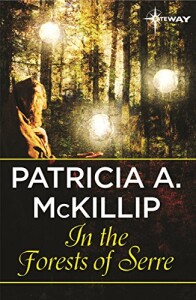 Patricia A. McKillip does something in In the Forests of Serre that I don’t think I’ve ever noticed her doing before: there are recognizable elements of traditional folklore in the story. In fact, they are critically important parts of the story. And to top it off, in spite of the more-or-less Celtic-inspired feel of most of her work, they are from Slavic folklore.
Patricia A. McKillip does something in In the Forests of Serre that I don’t think I’ve ever noticed her doing before: there are recognizable elements of traditional folklore in the story. In fact, they are critically important parts of the story. And to top it off, in spite of the more-or-less Celtic-inspired feel of most of her work, they are from Slavic folklore.
Prince Ronan of Serre, returning from a battle which, regrettably to his mind, he survived, has the misfortune to kill one of the witch Brume’s chickens: she is feeding her chickens on the forest path when his horse steps on it. However, he knows better than to accept her invitation to come into her house and partake of a broth she will prepare from the squashed chicken. She then curses him – not only will he have a bad day, but once he leaves his father’s castle, he will not find it again until he finds her. She then enters her house made of bones; the house rises, showing her stocky legs and huge splayed feet, and runs off into the forest.
Ronan has a bad day indeed: arriving home, he finds that hiss fiancée, Sidonie of Dacia, will arrive in three days; he will be wed the day after. Ronan is still in mourning for his wife and child and has no wish to marry again. Ferus of Serre is not a particularly understanding father, and they come to blows. Ronan leaves, and is lost in the forest.
Sidonie, meantime, is no happier about the arrangements than Ronan is. Ferus wants this match because, although the Kings of Serre have no magic, the land does, and the Kings of Dacia have been noted sorcerers for generations. Sidonie has inherited none of their talent. Nevertheless, she sets off accompanied by the wizard Gyre, who is repaying a debt owed to the wizard Unciel, greatly weakened and unable to make the trip himself. One night as they near the castle of Serre, Sidonie encounters Ronan, now starved and wild-looking – he has seen the firebird, and must follow it. Gyre also encounters Ronan, and decides that he will have his own magic power and rule Serre and its magic as well. And the witch Brume instructs Ronan to bring her the firebird if he wishes ever to go home again. The story has a few more wrinkles, such as the dreadful creature that was about to consume Gyre when Unciel saved him at the cost of his own strength, and the canny machinations of Calandra, Ronan’s mother, not to mention the firebird itself.
The firebird, the subject of Stravinsky’s ballet, is a well-known story from Slavic folklore. It is generally the object of a difficult, if not impossible, quest; in this case, Ronan pursues the firebird first for itself – it is sometimes the firebird, sometimes the most beautiful woman he has ever seen – and then because he must to gain back his heart, which Brume holds. Sidonie, as well, pursues the firebird, also in quest of Ronan’s heart – she doesn’t want to marry a heartless man.
Brume is built from the Russian and Polish tales of Baba Yaga (in Polish, Baba Jaga). In many stories she has a house that moves, seemingly of its own will, and usually through the agency of chicken legs, so it’s no surprise that chickens are important to Brume. Needless to say, Brume is not a “good” witch, but she is not really what we would call “bad,” either – McKillip portrays her as someone with her own agenda, whose motivations are not entirely human.
There is another supernatural player here – the monster that Unciel defeated. It’s not really dead, as we learn – in the course of the story, Unciel, Gyre and Ronan all wear its face, a face that is horrible to look on, empty, cruel – heartless.
I’ve been reading a lot of McKillip lately, and In the Forests of Serre is one of the most impressive of her books I’ve come across. She brings us her signature themes – love, redemption, growth and maturation – with a slightly different slant. Identity, which is always under the surface of her work, here takes a prominent place, as Gyre becomes Ronan, Ronan becomes a Ferus in the making, and Sidonie herself dons a disguise to escape from Serre. The firebird and Brume seem to have no fixed identities, or at least the outward aspects of their personae are fluid, while the nameless monster insinuates itself into many of the characters.
Add into the mix what is one of the best realizations of McKillip’s characteristic style, her laconic poetry, the subtly and fully realized characters, her matter of fact renderings, and we have an exceptional story, indeed.
(Ace Books, 2003)
Patricia A. McKillip’s website is here. There is a good bibliography of McKillip’s writing at Fantastic Fiction.
